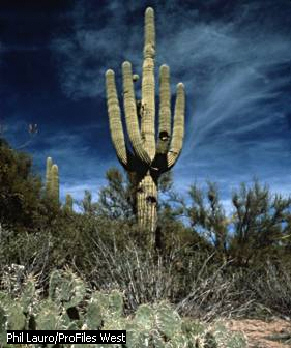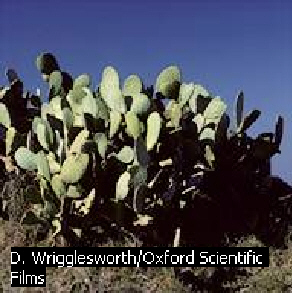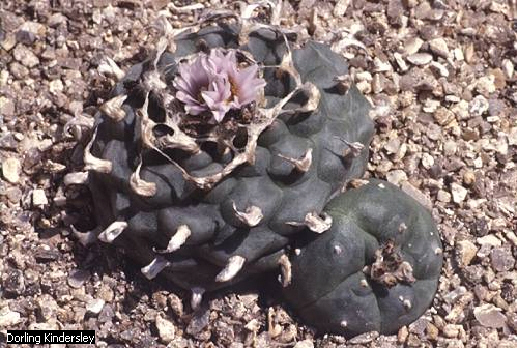HOME
PLANTS
Cacti
(plural of Cactus)

 The
saguaro cactus, common in Arizona's desert areas,
branches only after it has reached a height of about 15 feet. The
saguaro grows very slowly, approximately 1 inch per year, and can
reach heights of up to about 50 feet. Featured on a United States
postage stamp in 1962, the plant's waxy white blossom is Arizona's
state flower. Phil Lauro/ProFiles West
The
saguaro cactus, common in Arizona's desert areas,
branches only after it has reached a height of about 15 feet. The
saguaro grows very slowly, approximately 1 inch per year, and can
reach heights of up to about 50 feet. Featured on a United States
postage stamp in 1962, the plant's waxy white blossom is Arizona's
state flower. Phil Lauro/ProFiles West
The saguaro cactus grows in parts of
Arizona, eastern California, and northern Mexico at elevations below
4000 feet. One of the largest of the cactus species, the saguaro has
spines up to 3 inches long. Its white flowers generally open only at
night. The fruit is red. Dorling Kindersley
Cactus is the common name for the
family comprising a peculiar group of spiny, fleshy plants native to
the North America. The family contains about 1650 species, most of
which are adapted to arid climates. The fruits of cacti are important
sources of food and drink in many areas to which they are native.
Because cacti require little care and exhibit bizarre forms, they are
popular for home cultivation and are coming under increasing pressure
as a result. More than 17 kinds of cacti now face extinction because
of plundering by avid collectors and professional poachers,
especially in the southwestern United  States
and northern Mexico.
States
and northern Mexico.
The Christmas cacti are a group of bushy
perennial cacti growing to a height of about 5 inches. These cacti
are often found in shaded areas in rich, well-drained soils. John
Kaprielian/Photo Researchers, Inc.
The organ pipe cactus grows in parts of
Arizona, Baja California, and northern Mexico at elevations below
1000 m (3000 ft). The organ pipe reaches a height of 20 feet and has
white flowers and red fruit. Stan Osolinski/Oxford Scientific Films
Cactus plants usually consist of
spiny stems and roots. Leaves are greatly reduced or entirely absent.
Only in two genera are fully formed leaves present. The stems of
cacti are usually swollen and fleshy, adapted to water storage, and
many are shaped in ways that cause rain to flow directly to the root
system for absorption. The roots form extensive systems near the soil
surface, assuring that a given plant will absorb the maximum amount
of water from a wide area; plants in deserts are usually widely spaced.
The most distinctive vegetative
feature of cacti is the areoles, specialized areas on the stems on
which stiff, sharp spines usually grow. Some cacti lack spines but
have hairs or sharp, barbed structures called glocids on the areoles.
Areoles develop from lateral buds on the stems and appear to
represent highly specialized branches.

There are four species of barrel cactus in the
genus Ferocactus growing in parts of Baja California, Mexico,
Arizona, and  California
at elevations below 6000 feet. Depending on the species, barrel
cactus plants reach a maximum size of 5 to 10 feet. The flowers are
generally a yellow, greenish-yellow, purplish-red, or orange color.
Stan Osolinski/Oxford Scientific Films
California
at elevations below 6000 feet. Depending on the species, barrel
cactus plants reach a maximum size of 5 to 10 feet. The flowers are
generally a yellow, greenish-yellow, purplish-red, or orange color.
Stan Osolinski/Oxford Scientific Films
The prickly pear cactus is found throughout the
southwestern United States, Baja California, and the Sonoran Desert
region of Mexico. Prickly pears have whitish, yellow, orange, or red
flowers and greenish-brown, yellow, yellowish-green, red, or purple
fruit, which are suitable for human consumption. The cactus plants
themselves are also edible and are commonly used for livestock feed.
D. Wrigglesworth/Oxford Scientific Films
The flowers of cacti are often
large and showy and occur singly rather than in clusters of several
flowers. The perianth (floral tube) does not consist of sharply
differentiated sepals and petals, but rather of a series of bracts
(modified leaves), which gradually grade into sepals and finally into
showy petals. The flowers have many stamens; the ovary is inferior
and fused to the perianth. The fruits are often brightly colored and fleshy.
 The
jumping cholla, native to rocky deserts and hillsides of Baja
California, northern Mexico, Arizona, and New Mexico, grows to a
height of 5 m (15 ft). The plant has lavender flowers and a greenish
fruit that grows in a chainlike fashion over a period of years. T.
Middleton/Oxford Scientific Films
The
jumping cholla, native to rocky deserts and hillsides of Baja
California, northern Mexico, Arizona, and New Mexico, grows to a
height of 5 m (15 ft). The plant has lavender flowers and a greenish
fruit that grows in a chainlike fashion over a period of years. T.
Middleton/Oxford Scientific Films
 Peyote
cacti produce the chemical known as mescaline in their
mushroom-shaped caps. When the caps, or buttons, are dried and eaten,
brewed into tea, or powdered into capsules, the mescaline becomes an
active hallucinogenic agent. Native Americans have used peyote since
pre-Columbian times as part of their religious rites, believing the
vivid color hallucinations to have spiritual relevance. Dorling Kindersley
Peyote
cacti produce the chemical known as mescaline in their
mushroom-shaped caps. When the caps, or buttons, are dried and eaten,
brewed into tea, or powdered into capsules, the mescaline becomes an
active hallucinogenic agent. Native Americans have used peyote since
pre-Columbian times as part of their religious rites, believing the
vivid color hallucinations to have spiritual relevance. Dorling Kindersley
Most of the 130 or so genera of
cacti are found in cultivation, the small, slow-growing species being
most popular because of their variety in shapes, colors, and spines.
One of the best-known is a group containing beautiful night-blooming
flowers and the familiar saguaro plant. In some classifications, this
group is split into as many as 10 separate genera. Still more widely
grown is the group containing the Christmas cactus. Species of this
group, which naturally occur as air plants in tropical rain forests,
do not fit the popular idea of cacti as squat, fleshy plants of
desert regions. Examination of their stems, however, reveals the
presence of the cactus family's unique areoles; their flowers have
the typical cactus features.
 Many
groups of plants that are unrelated to cacti have also adapted to
survive in arid regions and often resemble cacti in appearance. These
offer examples of parallel evolution: Unrelated organisms subjected
to similar environmental stresses often evolve similar anatomical and
functional characteristics. For example, many spurges that grow in
dry parts of Africa, where cacti are not found, exhibit leafless,
spiny, fleshy stems.
Many
groups of plants that are unrelated to cacti have also adapted to
survive in arid regions and often resemble cacti in appearance. These
offer examples of parallel evolution: Unrelated organisms subjected
to similar environmental stresses often evolve similar anatomical and
functional characteristics. For example, many spurges that grow in
dry parts of Africa, where cacti are not found, exhibit leafless,
spiny, fleshy stems.
Although all three of the plants in this picture
appear to be cactus plants, the one to the far left is a spurge, not
a true cactus. While both the cactus and the spurge have reduced,
spiny leaves to prevent water loss and a large, succulent stem for
water storage, they are quite different plants, distinguished by the
presence of a milky latex-like fluid in the stem of the spurge. This
similar adaptation to their arid environment is an example of
convergent evolution. Dorling Kindersley
Scientific classification: Cacti make up the family
Cactaceae. Cacti with fully formed leaves are classified in the
genera Pereskia and Pereskiopsis. The night-blooming flowers and the
saguaro plant are classified in the genus Cereus. The Christmas
cactus is classified as Schlumbergera bridgesii.
Contributed By: Marshall R. Crosby

 The
saguaro cactus, common in Arizona's desert areas,
branches only after it has reached a height of about 15 feet. The
saguaro grows very slowly, approximately 1 inch per year, and can
reach heights of up to about 50 feet. Featured on a United States
postage stamp in 1962, the plant's waxy white blossom is Arizona's
state flower. Phil Lauro/ProFiles West
The
saguaro cactus, common in Arizona's desert areas,
branches only after it has reached a height of about 15 feet. The
saguaro grows very slowly, approximately 1 inch per year, and can
reach heights of up to about 50 feet. Featured on a United States
postage stamp in 1962, the plant's waxy white blossom is Arizona's
state flower. Phil Lauro/ProFiles West States
and northern Mexico.
States
and northern Mexico.

 California
at elevations below 6000 feet. Depending on the species, barrel
cactus plants reach a maximum size of 5 to 10 feet. The flowers are
generally a yellow, greenish-yellow, purplish-red, or orange color.
Stan Osolinski/Oxford Scientific Films
California
at elevations below 6000 feet. Depending on the species, barrel
cactus plants reach a maximum size of 5 to 10 feet. The flowers are
generally a yellow, greenish-yellow, purplish-red, or orange color.
Stan Osolinski/Oxford Scientific Films The
jumping cholla, native to rocky deserts and hillsides of Baja
California, northern Mexico, Arizona, and New Mexico, grows to a
height of 5 m (15 ft). The plant has lavender flowers and a greenish
fruit that grows in a chainlike fashion over a period of years. T.
Middleton/Oxford Scientific Films
The
jumping cholla, native to rocky deserts and hillsides of Baja
California, northern Mexico, Arizona, and New Mexico, grows to a
height of 5 m (15 ft). The plant has lavender flowers and a greenish
fruit that grows in a chainlike fashion over a period of years. T.
Middleton/Oxford Scientific Films Peyote
cacti produce the chemical known as mescaline in their
mushroom-shaped caps. When the caps, or buttons, are dried and eaten,
brewed into tea, or powdered into capsules, the mescaline becomes an
active hallucinogenic agent. Native Americans have used peyote since
pre-Columbian times as part of their religious rites, believing the
vivid color hallucinations to have spiritual relevance. Dorling Kindersley
Peyote
cacti produce the chemical known as mescaline in their
mushroom-shaped caps. When the caps, or buttons, are dried and eaten,
brewed into tea, or powdered into capsules, the mescaline becomes an
active hallucinogenic agent. Native Americans have used peyote since
pre-Columbian times as part of their religious rites, believing the
vivid color hallucinations to have spiritual relevance. Dorling Kindersley Many
groups of plants that are unrelated to cacti have also adapted to
survive in arid regions and often resemble cacti in appearance. These
offer examples of parallel evolution: Unrelated organisms subjected
to similar environmental stresses often evolve similar anatomical and
functional characteristics. For example, many spurges that grow in
dry parts of Africa, where cacti are not found, exhibit leafless,
spiny, fleshy stems.
Many
groups of plants that are unrelated to cacti have also adapted to
survive in arid regions and often resemble cacti in appearance. These
offer examples of parallel evolution: Unrelated organisms subjected
to similar environmental stresses often evolve similar anatomical and
functional characteristics. For example, many spurges that grow in
dry parts of Africa, where cacti are not found, exhibit leafless,
spiny, fleshy stems.